Do blue watermelons exist or is it an internet myth
Watermelon is a familiar part of the summer menu. Even children know what a fruit with red flesh and dark seeds looks like. But not so long ago, there was news on the network about an amazing blue watermelon. The creators assured that this is a new variety, the pulp of which has an unusual color and unique taste. Everyone was offered to buy seeds and grow this unusual culture.
Do such fruits really exist or is it a hoax? In the article you will find a detailed answer to this question.
The content of the article
Japanese blue watermelon
The first mentions of this unusual variety appeared on the Internet in May 2011.... The blue watermelon was developed in Japan and was called Lunar (or Ashidus). According to the assurances of sellers, he grew up in only a few Japanese areas.
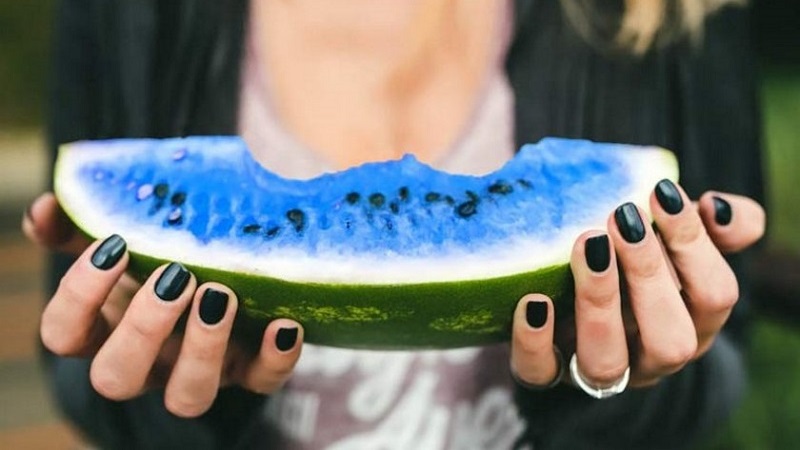
The creators of this miracle of selection claimed that the person who ate it dramatically changes the taste perception. Sour seems to him sweet, salty - bitter, and plain water acquires a pronounced orange flavor.
Interesting fact. The price of the new item corresponded to the amazing qualities stated in the description. Asidus cost 16,000 yen (roughly $ 200) per kilogram. But she did not scare away exotic lovers. Those who wanted to taste the unusual berry were enough.
Truth or fiction
Photos of berries with blue and blue pulp have appeared on resources such as Snopes, Tumblr, Yahoo Answers, and Pinterest have generated a lot of controversy and discussion. Some were convinced that this unusual color was the result of exposure to strong chemicals. These users discouraged others from experimenting with food.
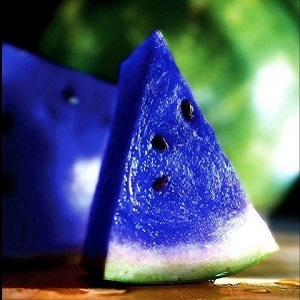 The topic of GMOs was often raised in discussions. The most popular was the version with chemical dyes that changed the usual red color of the fruit.
The topic of GMOs was often raised in discussions. The most popular was the version with chemical dyes that changed the usual red color of the fruit.
Japan and China have long established themselves as suppliers of highly exotic things., so blue watermelons did not stand out too much from the rest of the products. This is probably why users so easily accepted the existence of Asidus and boldly ordered it.
Some users reacted to these photos with suspicion. There were also those who believed that a rich shade of pulp was not an achievement of breeders, but masters of Photoshop or another graphic editor.
Exposure
The suspicions of skeptics doubting the achievements of Japanese breeders have been confirmed... Thanks to Google, the original photograph of Asidus was found. It had an ordinary red watermelon, and its blue color was the result of color correction in a graphics editor. The news that caused such a resonance turned out to be an ordinary fake (deception).
Soon enough, a number of revealing videos appeared on the network.... On them, people showed how in a few clicks to give the red pulp a rich blue hue.
It is interesting. Fictions about the amazing ability of blue watermelon to change the taste of products have a very real basis. The Magic Berry (Sunsepalum Dulcificum) growing in West Africa has this property. Its fruits contain glycoprotein and miraculin, which act on the taste buds of the tongue. After eating this fruit, the sour begins to seem sweet.
Growing blue watermelons
 The exposure did not bother the merchants. Asidus seeds were still being sold on the Chinese website Aliexpress. This the product turned out to be extremely popular and many people ordered it... Some even filmed the process on video or wrote about it on their pages in social networks.
The exposure did not bother the merchants. Asidus seeds were still being sold on the Chinese website Aliexpress. This the product turned out to be extremely popular and many people ordered it... Some even filmed the process on video or wrote about it on their pages in social networks.
Time passed, but gullible buyers never saw any blue berries. From the delivered seeds, the usual red fruits grew. But more often than not, they did not germinate at all. The reason was that expired seeds were often sent to customers.
Representative of the Moscow Interregional Union of Gardeners V. Lukanin commented this situation is like this: “Did you buy a blue watermelon? God grant that you grow up simple. It will be red. But the protection period for the buyer has already passed, because in 60 days you will not have time to grow anything. "
It really is. Two months is not enough to get a crop that will confirm the fact of deception. Some particularly cunning sellers even offer seeds in the off-season to completely protect themselves from a possible refund.
Traditional varieties of watermelons:
Customer reviews were not long in coming... Here are some of them:
- "Nonsense - ordinary, red grows from such seeds."
- “I bought, planted, in the end nothing grew.”
- "The seeds have come, we will try to grow ...". After 1.5 months, the review was supplemented: "Strawberries have risen!"
- "The goods did not come, return the money!"
Unfortunately, human gullibility is strong. The sellers were proven dishonest and even found the original advertising photo of Asidus. It may seem like this question is closed, but many people still believe in the existence of blue watermelon. On the net you can find many articles describing this variety and even recipes for dishes. Some are still trying to grow it.
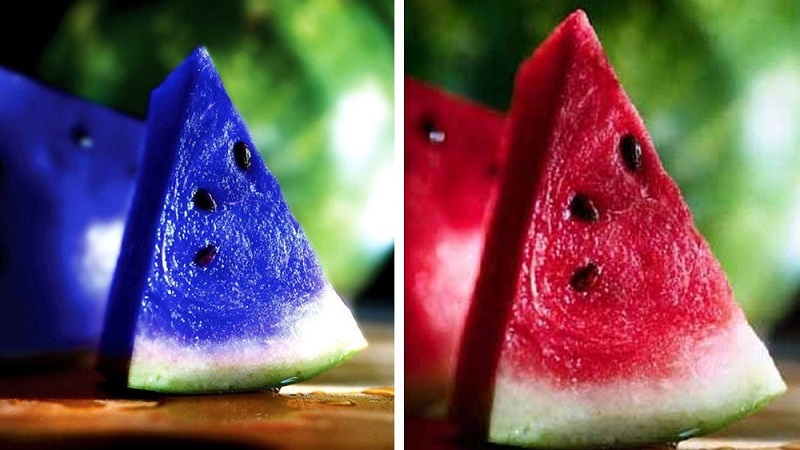
Unusual varieties of watermelons
Although blue watermelon turned out to be a deception of enterprising and dishonest merchants, the world there are many varieties of this berry, the shape and colors of which surprise no less... There are about 1200 varieties of watermelons, and among them there are extremely unusual specimens.
It is interesting. We can judge about the breeding path of watermelon by the works of Renaissance artists. A still life painted by Giovanni Stanki in the 17th century shows what this berry looked like 400 years ago. Its flesh had a different color, and the seeds were much larger.
Snow white watermelon
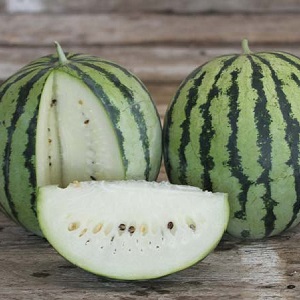 The white color of the pulp is considered to be or a sign of an unripe fruit, or the result of severe chemical treatment. But there is a type of watermelon for which this color is a characteristic feature. This is a variety called White Miracle.
The white color of the pulp is considered to be or a sign of an unripe fruit, or the result of severe chemical treatment. But there is a type of watermelon for which this color is a characteristic feature. This is a variety called White Miracle.
It was obtained by crossing wild-growing watermelon from South Africa and its cultivated relative. The rind of the White Miracle is green with a dark strip and thin, and the flesh is uniformly white and translucent. She has a slight strawberry and fresh cucumber flavor.
Do not confuse white and unripe watermelons. A berry harvested ahead of time has a number of signs:
- White bloom is visible on the peel.
- The pulp is unevenly colored, loose and with voids.
- Seeds are white.
- Yellow or white streaks are often present in the pulp (a sign of nitrite).
You can't eat such watermelons!
Yellow watermelon
 In Thailand, breeders managed to bring out another unusual variety... Outwardly, it is completely unremarkable: small in size, oval in shape and a green peel with dark stripes. But the pulp of this berry has a rich yellow color.
In Thailand, breeders managed to bring out another unusual variety... Outwardly, it is completely unremarkable: small in size, oval in shape and a green peel with dark stripes. But the pulp of this berry has a rich yellow color.
Like the White Miracle, this variety was obtained by crossing wild and domestic plants.... Later, berries similar to it were successfully bred in Russia and Spain. The Lunny variety, bred in Russia, has gained popularity in Asian countries. The Thais, Chinese and Spaniards love yellow watermelons even more than red ones, but in Russia they are not very popular.
Yellow watermelons are sweeter than red ones and have fewer seeds in their fruits... In some varieties, gourmets distinguish the flavor of mango, pumpkin or lemon. In 2013, Russian breeders even managed to get a variety with a nutmeg flavor.
It is interesting... It is yellow that is the original color of watermelon pulp. The wild relatives of modern watermelons have small fruits with golden and bitter flesh.
Seedless watermelon
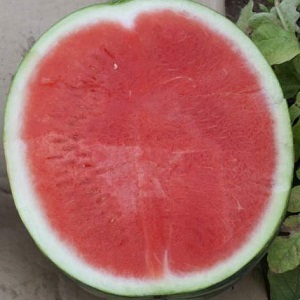 Many watermelon lovers spoil the pleasure of the bones. This problem was solved in the 40s and 50s. The Japanese managed to breed a seedless variety for the first time... The novelty was quickly appreciated. Soon, similar varieties appeared in the USA, Venezuela, Bulgaria and Russia.
Many watermelon lovers spoil the pleasure of the bones. This problem was solved in the 40s and 50s. The Japanese managed to breed a seedless variety for the first time... The novelty was quickly appreciated. Soon, similar varieties appeared in the USA, Venezuela, Bulgaria and Russia.
The flesh of boneless watermelons is slightly looser and waterythan usual, but it is sweeter. This is due to the higher sugar content. Outwardly, they do not stand out in anything: green peel with stripes and medium size.
Now these varieties are grown mainly in the USA and Israel.... In American supermarkets, you can buy whole fruits, or already cut in half or into quarters.
It is interesting:
Why is watermelon juice useful and how to prepare it correctly
Simple and effective watermelon masks for face and hair
Is it possible to eat watermelon on an empty stomach and when problems may arise
Square watermelon
 Manufacturers can surprise the buyer not only with an unusual color, but also with a non-standard shape. So, in the summer of 2007, cubic watermelons became widespread in Japan... Unlike blue watermelon, this is not just another invention of businessmen, but a real product.
Manufacturers can surprise the buyer not only with an unusual color, but also with a non-standard shape. So, in the summer of 2007, cubic watermelons became widespread in Japan... Unlike blue watermelon, this is not just another invention of businessmen, but a real product.
Its creation is dictated by rationality. Fruits of this shape are much more convenient to store. and transport. They save space when stacking and do not roll over during transport.
The cost of these sweet cubes is around $ 80... They are often purchased as an unusual gift.
It is interesting. The imagination of Japanese gardeners was not limited to one square shape. Now on sale you can find not only cubic watermelons, but also pyramid-shaped berries and even a human head.
Watermelon with white skin
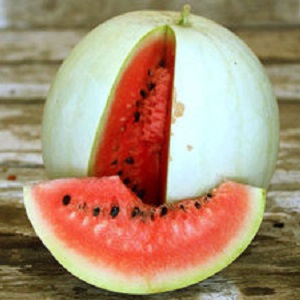 There is another variety of white watermelon. It was bred by American breeders and named Navaggio Winter. Its flesh is the usual red or pink color, and the rind is almost white. These watermelons are crispy and sweet.
There is another variety of white watermelon. It was bred by American breeders and named Navaggio Winter. Its flesh is the usual red or pink color, and the rind is almost white. These watermelons are crispy and sweet.
Navajo Winter easily tolerates lack of moisture... This makes it suitable for cultivation in arid areas. Another advantage of the variety is the ability to store it for a long time.
Harvested crop up to four months does not deteriorate and retains its taste.
Black watermelon
 At the other end of the light spectrum is the work of Japanese gardeners.... In the 80s, they managed to get an absolutely black watermelon. The cultivar grown in the city of Toma is called Densuke.
At the other end of the light spectrum is the work of Japanese gardeners.... In the 80s, they managed to get an absolutely black watermelon. The cultivar grown in the city of Toma is called Densuke.
Densuke fruits are round and have a medium thickness.... The pulp is deep red, sweet and juicy. The taste of this watermelon practically does not differ from the usual green one.
Densuke are not cheap... The average price is about 25,000 yen ($ 250) per piece. Such a high cost is due not only to the exotic colors of watermelons, but also to their rarity. Densuke is grown exclusively on the island of Hokkaido, and no more than 10,000 pieces are sold per year.
It is interesting. Densuke is composed of two characters for rice field and help. The fact is that in the 80s there was a rice crop failure - this crop was the main source of income for Toma's farmers. To save the business, it was decided to switch to the cultivation of unusual watermelons.
Dwarf watermelon
 Of all the variety of watermelons, the smallest representative of this species is remarkable - Melotria hummingbird is native to Africa. Its length is only a few centimeters. Outwardly, it looks like a smooth gherkin with longitudinal stripes.
Of all the variety of watermelons, the smallest representative of this species is remarkable - Melotria hummingbird is native to Africa. Its length is only a few centimeters. Outwardly, it looks like a smooth gherkin with longitudinal stripes.
Popular as an appetizer and ingredient in summer salads.... But sweet lovers will be disappointed. Melotria tastes more like a cucumber. It is because of this that the watermelon received another name - the African cucumber. Some people consider Melotria hummingbird to be a cucumber with the appearance of a watermelon, some refer to it as a watermelon with a cucumber flavor.
African cucumber can also be grown in Russia. Its seeds are sold at specialized marketplaces in online supermarkets. On the forums and sites there are many reviews from those who really managed to grow them and get the harvest.
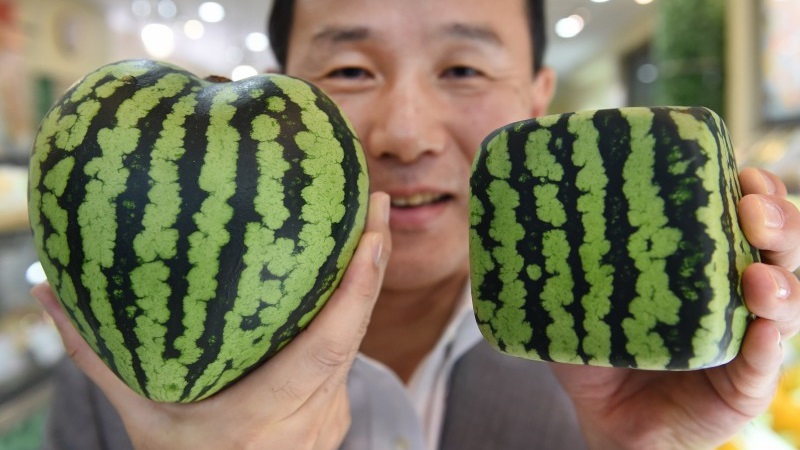
Conclusion
Chinese sellers have reiterated the need to be skeptical about advertising beliefs. Blue watermelon turned out to be just a clever marketing ploy that forced gullible buyers to fork out.
However, there are many real original varieties of this berry in the world. Be vigilant and bon appetit!